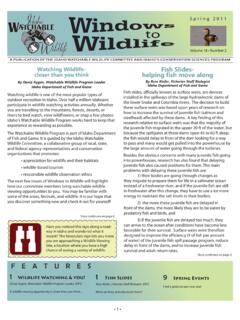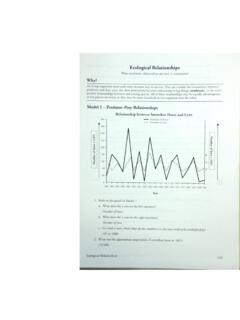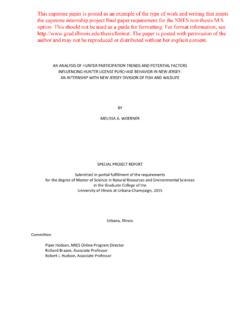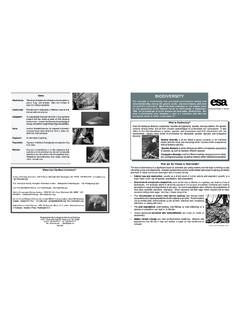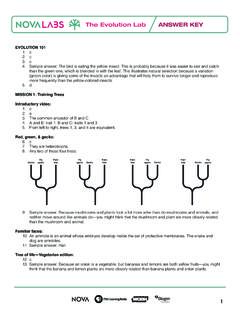Transcription of Idaho's Birds of Prey
1 A publication of the Conservation Sciences ProgramIDAHOIDAHOFISH & GAMEFISH & GAME Raymond ParsonsBirds of PreyIdaho sRed-tailed hawk2 Birds of PreyImmature red-tailed hawk, Raymond ParsonsHumans have had a long and often contradictory relationship with raptors. We have respected and even revered them as symbols of nobility, strength, and freedom. The hawk was often represented in ancient Egyptian hieroglyphics. The eagle has been used as a national emblem since the time of Imperial Rome. Native Americans of many tribes believe the eagle and other raptors have sacred raptors also have been viewed as varmints , as our competitors for wildlife, or killers of domestic livestock. For example, in 1917, a bounty was placed on bald eagles in Alaska because fi shermen were worried about decreasing numbers of salmon. More than 100,000 eagles were killed before the bounty was lifted in 1953.
2 In fact, humans had caused the salmon s decline by overharvesting. Most of the eagles had been feeding on spawned-out, dead, or dying fi sh that had no commercial , some hunters still blame raptors when gamebirds are scarce. But biologists have found that harsh winters, cold, wet springs, and habitat loss have a far greater impact than raptors on Idaho s chukars, grouse, quail, and pheasant chicken hawk label is slowly dying, but falcons, hawks, and even sometimes eagles are still being shot despite protection under state and federal laws. Only recently have we begun to appreciate the importance of these Birds , not just as symbols or for their beauty, but as key members of natural Birds of prey , and other predators, we can learn about the health of our environment. If something is harming them, it is likely to endanger us as well.
3 That is because we are predators, too we are at the very top of the earth s food chain, just like raptors. Any poison that kills or limits reproduction of the animals and plants we eat, or that enters the water we drink, could also harm us if allowed to reach high enough the early 1960s, this early warning system sounded: Birds of many species began dying at alarming rates. Scientists went to work to see why. They found that pesticides such as DDT had been concentrating in the tissues of mammals, Birds , and fi sh the declining Birds of prey 3 Pearson Education, Inc. pubishing as Benjamin Cummingsbirds were eating. As the poison built up, the Birds either died outright, or could not reproduce because their eggshells were so thin they broke before hatching. Although all raptors were victims, the peregrine falcon and the bald eagle were brought to the edge of extinction.
4 DDT was banned in 1972, but it is still being made and used by other countries. Thus it continues to threaten Birds that migrate to these southern aid ranchers and farmers by keeping rabbits, rodents, and insects in check. Grasshoppers, which eat crops and forage, are prey for the smaller haven t always been grateful for their help. Since 1900, our activities have greatly aff ected raptors almost everywhere. Perhaps the most damage has come not from illegal shooting or accidental poisoning, or by DDT, but from a steady loss of food and habitat. An eagle or a falcon must have a large area in which to fi nd enough prey to eat and feed its young. Each bird , or pair of Birds , will defend that area as its own territory. So raptors or any type of predator are never very abundant even in the best of habitats. It is true that some species, like the kestrel or even the peregrine, can adapt to human presence in farmland or cities.
5 But others cannot survive close to us. As forest and sageland fall under the ax or yield to the plow, native raptors and their prey will diminish. 4 Birds of PreyBBiologyAPPEARANCE/IDENTIFICATION:Ra ptors are Birds of prey that hunt, kill, and eat animals. They are characterized by:powerful feet with curved, sharp talons to capture their preya hooked beak to tear apart fl esh keen eyesight that helps them hunt for foodIdaho has a rich variety of raptors and is fortunate to call seventeen species of diurnal (active in the daylight) raptors its neighbors. If you have seen an eagle soaring silently past the towering walls of the Snake River Canyon; if you sighted a kestrel or harrier looking for a meal along a busy highway; if you have heard the wild cry of an osprey high above the morning mist of an Idaho lake, then you already know the unique combination of beauty and effi cient design that sets raptors apart from other winged raptors are classifi ed in the order FALCONIFORMES, which is then divided into four diff erent families: New World vultures (Cathartidae) falcons ( Falconidae) hawks and eagles ( Accipitridae) osprey (Pandionidae) This basic raptor design (sharp talons, hooked beak, and keen eyesight) is modifi ed in certain species, depending on the main prey and method of pursuit and capture.
6 For instance, falcons have a notched upper beak for breaking the necks of small Birds and mammals they catch with their feet. Ospreys, which feed exclusively on fi sh, have an outer toe that can rotate to grip their slippery prey . Since vultures do not kill, but only scavenge on carcasses, their feet are weak (like a chicken s) but their beak is strong for Red-tailed hawk Raymond Parsons Birds of prey 5 Raymond ParsonsNorthern harrier, femaletearing fl esh. Raptors regurgitate the indigestible parts (bones, fur, feathers, claws, teeth, and chitin) in the form of compact, oval pellets. In most raptor species the male and female look very much alike, but the female is generally up to one-third larger than males of the same species. The size diff erence between males and females allows a mated pair to hunt a greater variety of prey within their territory.
7 Color may vary between individuals, although males and females generally have similar plumage. In addition, some species have color phases individuals that are darker or lighter than most of the population. This is a genetically controlled characteristic; each bird remains in the same phase throughout its Birds of Preybald eagleturkey vultureOsprey: a large raptor with sharply crooked wings which create a gull-like appearance; wingbeat is stiff and harrier: medium-sized raptor with long, narrow wings and long tail; often rocks back and forth in fl : small to large-sized raptor with relatively short rounded wings and long tails; typical fl ight is a series of fl aps punctuated by a : medium-to large-sized raptors with broad wings and short tails; buteos soar frequently and wingbeats are slow, heavy, and : small to large raptors with long, tapered wings pointed at the tips and long tails.
8 Fl ight is fast and direct, wingbeats are often continuous throughout fl siloutettesVultures and Eagles: large to very large, dark raptors with long, broad wings; both tend to soar and glide rather than beat wings; vultures hold wings in a bold dihedral, rocking back and forth in fl ight, while eagles hold their wings nearly horizontal, or shallowly dihedral, and their fl ight is steady. Birds of prey 7 Osprey Tom MunsonRReproductionRaptors nest in all types of habitats, from deserts to grasslands, forests to tundra, wetlands to mountains, and even cities. Some begin nesting in late January, like bald eagles along the Boise River. Others begin in March and April like prairie falcons in the Snake River Birds of prey area. Still others don t begin nesting behavior until May or June, like northern harriers and raptors return to the same nesting territory each spring.
9 Most raptors are long-lived Birds ; mated adults will defend the same feeding and nesting territory for many number of eggs that a raptor lays varies between species. This number is often related to the size of the raptor and the amount of prey available. Generally, larger raptors lay fewer eggs. If prey is abundant, the female may lay a larger clutch. Where food is scarce, the clutch size may be only 1 or 2 eggs, or none at all. Usually the female incubates the eggs and protects the young in the nest. Both sexes feed the young when they are ready to fl y (fl edge). Immature Birds are almost as large as adults but usually sport a diff erent plumage than their Birds of prey Tom Munson Tom MunsonAAmerican kestrel(Falco sparverius)Length: 8-10 in. (male); 9-11 in. (female)Wingspan: 20-22 in. (male); 21-24 in. (female) Weight: oz.
10 (male); oz. (female)Habitat: desert, open forest, marsh, grassland, farmland, and urban areasDESCRIPTION:As small as a robin, this brightly marked falcon has long, pointed wings and a long, square-tipped tail with a wide dark subterminal band and a white tip. Males have blue-gray wings and buff y underparts with spotting. The larger female has the same buff y underparts, but with streaks, and rusty-red wings barred with black. Both have two vertical stripes called mustaches near each eye and markings on the back of the head, which gives the appearance of two dark eyes. Tail-pumping when perched is a distinguishing AND FOOD:Widely found in North and South America, kestrels sometimes live year-round in Idaho, but immature Birds migrate south in the their search for dragonfl ies, grasshoppers, mice, and voles, kestrels hover almost constantly.




